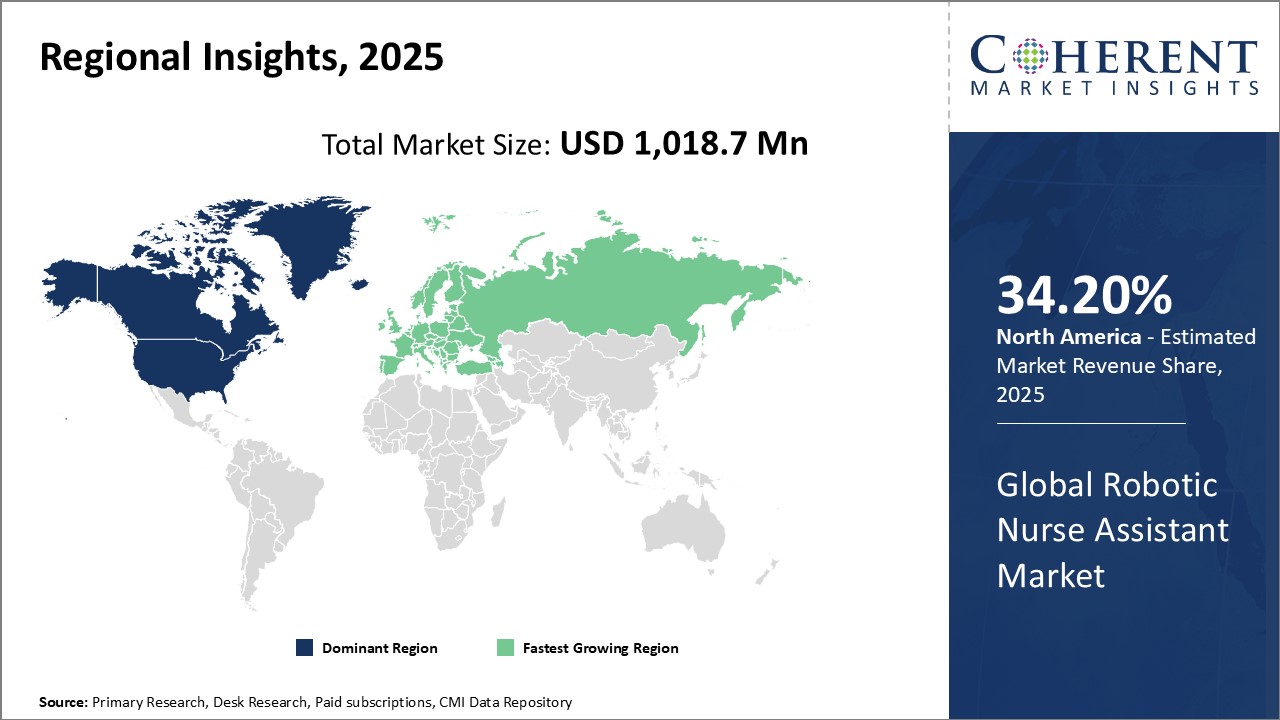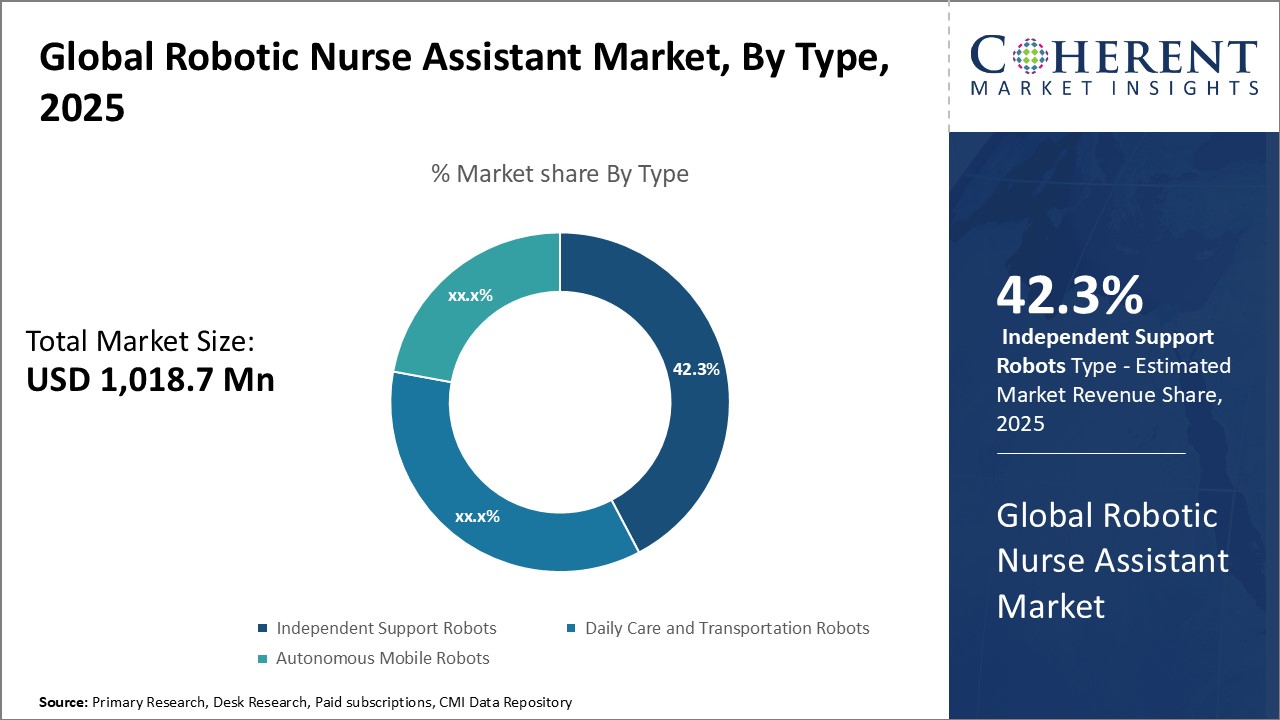The global robotic nurse assistant market was valued US$ 1,018.7 Mn in 2025 and is expected to reach US$ 3,131.4 Mn by 2032, growing at a compound annual growth rate (CAGR) of 17.4% from 2025 to 2032.
Global Robotic Nurse Assistant Market - Regional Insights
- North America is expected to be the largest market for robotic nurse assistant during the forecast period, accounting for over 34.2% of the market share in 2025. Large healthcare expenditure and the presence of major medical device manufacturers have established the U.S. as the clear leader in this space. Several North American hospitals have incorporated robotic nurse assistants to help streamline workflows and assist nursing staff with basic tasks. This has not only improved efficiency but also allowed nurses to focus more on critical patient care duties. This is expected to propel the growth of the robotic nurse assistant market over the forecast period
- Europe is expected to be the second-largest market for robotic nurse assistant, accounting for over 27.4% of the market share in 2025. Europe has a significant elderly population that requires extensive care, often for chronic diseases and disabilities. Robotic nurse assistants can help ease the burden on healthcare facilities by providing assistance with routine tasks, allowing human nurses to focus on more critical aspects of care. Moreover, there is a shortage of nursing staff in many European countries. Robotic nurse assistants can fill some of these gaps, taking over repetitive or strenuous tasks, such as lifting or moving patients, thereby reducing physical strain on human caregivers
- Asia Pacific is expected to be the third-largest market for robotic nurse assistant, accounting for over 21.9% of the market share in 2025. Nations like Japan and South Korea are well-known for their technological developments, particularly in robotics. This technical expertise facilitates the development, adoption, and acceptance of robotic nurse assistants. There has been a significant investment in healthcare technology from both public and private sectors within APAC. These investments often lead to partnerships that encourage the development and implementation of robotics in healthcare.
Figure 1. Global Robotic Nurse Assistant Market Share (%), By Region, 2025

To learn more about this report, Download Free Sample
Analyst’s Views:
The robotic nurse assistant market has strong growth potential driven by the increase in elderly population globally which requires more healthcare assistance. Elderly care is a significant cost for governments, and with staff shortages, robotic assistants can help address this issue. Another major driver is the ongoing COVID-19 pandemic, which has increased the demand for technologies that minimize human contact and risk of infection for both patients and nurses. Robotic assistants can reduce disease transmission in healthcare facilities. However, high initial costs of these systems and replacement parts is a major restraint to adoption in cost-sensitive markets. User acceptance is also a challenge as both patients and nurses need to feel comfortable with robot's care abilities. Data privacy and security is another concern as patient information will be collected and stored by these devices. Regulations around robot-humans interactions may differ between regions and need to be addressed.
Global Robotic Nurse Assistant Market - Drivers
- Increasing Adoption of Robotic Nursing Assistant Devices: The healthcare industry has seen a huge surge in the adoption of robotic nursing assistant devices in recent years. Robotic nurse assistants are being deployed in hospitals, nursing homes, and ambulatory care centers to assist nurses and care providers with tasks like medication management, patient monitoring, and logistics. For instance, in January 2023, MultiCare Health System, which provides hospital, clinic, primary care, specialty, emergency and urgent care health care services across the Washington state, announced the introduction of four Moxi, robot assistants. Moxi, created by Diligent Robotics, operates as a human-centered robotics company, will serve as an aid to nurses and will not have patient interaction or go into patient rooms. Some of its duties include delivering lab samples and running patient medications, supplies, and other items for patient care.
- Shortage of nursing staff: The shortage of nursing staff is one of the key driving factors for the growth of the robotic nurse assistant market. With the growing aging population across geographies and rising healthcare needs, the demand for nurses and care professionals has increased significantly over the past few years. However, many developed countries are facing a severe shortage of nursing workforce. For instance, the U.S. Bureau of Labor Statistics projects that more than 275,000 additional nurses are needed from 2020 to 2030, and that employment opportunities for nurses will grow at 9 percent, faster than all other occupations from 2016 through 2026.
Global Robotic Nurse Assistant Market - Opportunities
- Untapped Emerging Markets: There are several emerging economies that currently have underdeveloped healthcare infrastructure and nurse staffing shortages which represent major market potential for robotic nurse assistants. Nations like India, Indonesia, Brazil, and many across Africa are experiencing rapid growth and aging populations and have a growing need to care for their elderly. However, these regions struggle to train and hire enough human nurses and caregivers to meet demand. Due to low wages and challenging working conditions, the nursing profession also faces high turnover rates that exacerbate the staffing crisis. If robotic nurse assistants can deliver cost-effective care and reduce the physical burdens on human nurses, it could help alleviate pressures on developing healthcare systems and improve standards of care for patients.
Global Robotic Nurse Assistant Market Report Coverage
| Report Coverage | Details | ||
|---|---|---|---|
| Base Year: | 2024 | Market Size in 2025: | USD 1,018.7 Mn |
| Historical Data for: | 2020 To 2024 | Forecast Period: | 2025 To 2032 |
| Forecast Period 2025 to 2032 CAGR: | 17.4% | 2032 Value Projection: | USD 3,131.4 Mn |
| Geographies covered: |
|
||
| Segments covered: |
|
||
| Companies covered: |
Hstar Technologies Diligent Robotics, Toyota Motor Corporation, RIKEN, Aldebaran, Panasonic Holdings Corporation, Fraunhofer IPA, ST Engineering Aethon, Inc., and Triage Staffing |
||
| Growth Drivers: |
|
||
| Restraints & Challenges: |
|
||
Uncover macros and micros vetted on 75+ parameters: Get instant access to report
Global Robotic Nurse Assistant Market – Trends
- Miniaturization and portability: The trend of miniaturization and portability is significantly influencing the robotic nurse assistant market. With advancements in microelectronics and computing, robotic assistants are becoming highly compact and portable compared to conventional stationary robots. This allows them to perform tasks more efficiently in varied settings within hospitals and at patients' homes. For instance, smaller robots can easily maneuver around hospital beds and patient rooms to deliver medicine, take vital measurements and monitor patients remotely. This reduces workload of nurses and aids constant surveillance of patients.
Global Robotic Nurse Assistant Market - Restraints
- Technical Issues Related to the Use of Nursing-Care Robots: The usage of robots in the healthcare sector and their increasingly growing interaction with humans raises a series of new and challenging safety and security questions. For that reasons, in order to act in a responsible way, all the involved entities, starting with the manufacturers, have to face the predictability issue and invest resources to identify in advance all the potential hazards that the implementation of nursing-care robots can entail. As a matter of fact, safety and avoidance of harm should be of utmost importance in healthcare domain when using robots because of the involvement of vulnerable people such as ill and older adults and children. There is the need for an improved technique that will eliminate or reduce safety-related failures as well as eliminating unpredictable behaviors. Another specific concern about security is on how to keep robots safe from being hacked. As powerful as technology become, it is important also to check the activities of hackers who might exploit the technology for nefarious activities.
Counterbalance: Implementing robust testing, continuous monitoring, and cybersecurity measures, alongside comprehensive training for healthcare professionals, can counterbalance technical issues related to nursing-care robots.
- Resistance from healthcare staff: The resistance from healthcare staff poses a significant challenge for the growth of the robotic nurse assistant market. Healthcare professionals are wary of how robots may disrupt the human-centric model of care delivery. Nurses in particular have reservations about robots replacing some of their routine tasks and altering the caring dynamic between themselves and patients. They fear robots can never match the level of empathy, communication skills and emotional support integral to nursing. While robots may take over menial duties to aid efficiency, nurses are concerned about over-reliance on technology compromising the human touch in care.
Figure 2. Global Robotic Nurse Assistant Market Share (%), By Type, 2025

To learn more about this report, Download Free Sample
Global Robotic Nurse Assistant Market - Recent Developments
New Product Launch
- On June 2023, Touchlabs leading edge of mobile product development company, announced that it had launched its telerobot named Välkky at Laakso Hospital, Finland, as part of a three-month pilot scheme. the robot is equipped with electronic skin technology that allows the transmission of tactile sensations such as pressure and vibration. Nurses will operate the robot through an electronic haptic glove and can use the technology to measure pulse, temperature and oxygen saturation.
Fund Raise
- On April 2022, Diligent Robotics, an Austin-based robotic automation company, announced that it had closed over US$ 30 million in Series B funding, bringing the total investment raised to date to nearly US$ 50 million. Diligent Robotics develops socially-intelligent service robots and artificial intelligence solutions that enable robots to collaborate within and adapt to human environments. The flagship product, Moxi, is a robot that performs delivery tasks for frontline healthcare teams. Stress and burnout have been a persistent problem in healthcare for years, creating a shortage of nurses and clinical staff.
Top Companies in the Global Robotic Nurse Assistant Market
- Hstar Technologies
- Diligent Robotics
- Toyota Motor Corporation
- RIKEN
- Aldebaran
- Panasonic Holdings Corporation
- Fraunhofer IPA
- ST Engineering Aethon, Inc.
- Triage Staffing
Definition: Robotic Nurse Assistant (RNA), also commonly referred to as a "nursebot" or "carebot," is a robotic system designed to assist nursing staff and caregivers in healthcare facilities. RNAs are developed with the intention to support the medical staff by performing routine tasks, such as lifting patients, monitoring vital signs, delivering medications, and providing companionship to patients. These robotic systems can vary widely in their capabilities, from simple mechanical lift assistance to more advanced artificial intelligence (AI)-enabled robots that interact with patients and healthcare providers.
Robotic nurse assistants are an emerging technology that have the potential to support and aid human nurses. There are mainly two types of robotic nurse assistants - mobile robots and stationary robots. Mobile robots resemble mobility assistive devices and are equipped with sensors and cameras to navigate hospital environments autonomously. They can transport medical supplies, linen, and food to different departments. Stationary robots have a fixed base but have removable appendages like arms equipped with grippers that can perform simple repetitive tasks like changing bed sheets and feeding patients.
Share
Share
About Author
Komal Dighe is a Management Consultant with over 8 years of experience in market research and consulting. She excels in managing and delivering high-quality insights and solutions in Health-tech Consulting reports. Her expertise encompasses conducting both primary and secondary research, effectively addressing client requirements, and excelling in market estimation and forecast. Her comprehensive approach ensures that clients receive thorough and accurate analyses, enabling them to make informed decisions and capitalize on market opportunities.
Missing comfort of reading report in your local language? Find your preferred language :
Transform your Strategy with Exclusive Trending Reports :
Frequently Asked Questions
Select a License Type
EXISTING CLIENTELE
Joining thousands of companies around the world committed to making the Excellent Business Solutions.
View All Our Clients




